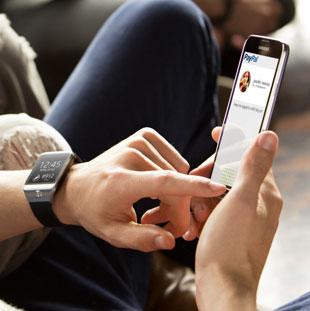Samsung refines Galaxy smartphone, launches three wearable Gear devices. Will consumers bite?


Mobile World Congress: 5 Hot Gadgets
Mobile World Congress: 5 Hot Gadgets (Click image for larger view and slideshow.)
Friday marks the worldwide launch of the Samsung Galaxy S5 smartphone and the Gear 2, Gear 2 Neo, and Gear Fit wearable. The devices are available in 125 countries, including the US, Europe, the Middle East, Latin America, and most Asian markets. They are being sold by wireless network operators in the US, including AT&T, Sprint, T-Mobile, Verizon Wireless, and others. Most carriers are asking $200 for the GS5 with a contract, or about $26 per month via installment plans.
The Galaxy S5 is a moderate upgrade to last year's GS4. The design is a bit conservative, but the materials and build quality are improved. One standout feature is the phone's IP67 rating, which means it's water- and dust-resistant: It can survive an afternoon at the beach, even if you drop it in the surf for a short time.
The GS5 has a 5.1-inch full HD screen, quad-core Snapdragon processor, 2GB of RAM, and 16 or 32 GB of storage. Network support runs the gamut, with Category 4 LTE, dual-band 802.11ac WiFi, Bluetooth 4.0 Low Energy, NFC, GPS, and GLONASS radios all on board. Shamefully, AT&T, Sprint, and Verizon Wireless have nixed one of the GS5's neatest tricks: Download Booster, a technology that uses WiFi and LTE together to speed up file downloads. Only the T-Mobile version includes the feature.
[Most users access the Web via iOS or Google. Read How Apps Won The Mobile Web.]
Samsung made strides with the smartphone's camera, simplifying the user interface. The sensor counts 16 megapixels and is capable of capturing 4K (Ultra HD) video. The camera has its own companion chip, and the GS5 can attain focus in a quick 0.3 seconds.
Another interesting addition is a heart rate monitor. The GS5 can detect the owner's pulse through a sensor on the back of the phone. The heart rate monitor ties in to Samsung's updated S Health suite of software, which aims to help owners manage diet and fitness. The GS5 also includes a fingerprint sensor, which is built into the home button on the front. Samsung says the sensor can be used as an added layer of protection for businesses and users who want to secure their devices. It can be used to lock individual files and folders. What's more, the sensor works with PayPal and can be used for swipe-and-pay purchases.
The Samsung GS5 runs Android 4.4.2 KitKat and employs Samsung's TouchWiz user interface. The UI is as cluttered and gimmicky as ever, but it offers an incredible array of tools, settings, and functions.
Samsung's new smart wearables come in three different flavors: the Gear 2, Gear 2 Neo, and Gear Fit.
The Gear 2 and Gear 2 Neo are more or less identical, except that the Neo has no camera. Each features a 1.63-inch touchscreen with 320 x 320 pixels, 1-GHz dual-core processor with 512 MB of RAM and 4 GB of storage, Bluetooth 4.0 Low Energy, and a 300-mAh battery that's good for several days of use. Unlike the original, the Gear 2's camera is built into the body of the watch itself rather than the strap. That means the strap can be interchanged, allowing owners to personalize their devices. The watch also includes an IR port and a remote control application for home theater equipment. Samsung says a few dozen apps will be available at launch (unlike the 80 that were available for the original Gear). Apps will include CNN, Expedia, eBay, Evernote, Feedly, Path, PayPal, and The Weather Channel. The Gear 2 costs $299; the Gear 2 Neo $199.
The Gear Fit has a curved AMOLED screen that is much wider than it is tall. The low profile makes it a more attractive workout companion. It has its own operating system, which is also toned down compared to the Gear 2/Gear 2 Neo. It has access to a handful of simple apps, most of which center on health and fitness. The Gear Fit, which costs $199, also includes a heart rate monitor. One crucial shortcoming of all three smartwatches: They work only with Samsung Galaxy-branded devices.
Samsung has a lot riding on the success of the GS5. Sales of the GS4, though significant, fell far short of Samsung's 100 million unit goal. The company hopes the tweaks and modifications in the GS5 will make it a more compelling device to consumers.
Far from fading away in the face of consumer-class competition from Google, Skype, LinkedIn, and others, unified communications is enjoying new relevance in enterprises -- there’s even an SDN connector for UC. To reflect these updates, InformationWeek revamped its UC survey for 2014. Take part in the InformationWeek 2014 Unified Communications Survey and be eligible to win a great prize. Survey ends April 18.
About the Author(s)
You May Also Like







